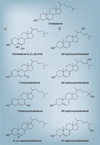Mechanisms of oxysterol-induced disease: insights from the biliary system
- PMID: 23630545
- PMCID: PMC3636558
- DOI: 10.2217/clp.12.53
Mechanisms of oxysterol-induced disease: insights from the biliary system
Abstract
Oxysterols are oxidized species of cholesterol that are derived from exogenous (e.g. dietary) and endogenous (in vivo) sources. Oxysterols play critical roles in normal physiologic functions as well as in pathophysiologic processes in a variety of organ systems. This review provides an overview of oxysterol biology from the vantage point of the biliary system. Several oxysterols have been identified in human bile in the context of biliary tract infection and inflammation. This finding has led to investigations regarding the potential pathophysiologic significance of biliary oxysterols in diseases affecting the biliary system, with an emphasis on cholangiocarcinoma. Emerging evidence implicates specific oxysterols in the development and progression of this malignancy. This review will summarize the literature on oxysterols in the biliary system and discuss how the accumulated evidence contributes to a hypothesis describing the molecular basis of cholangiocarcinogenesis.
Keywords: Opisthorchis viverrini; bile; bile acids; biliary tract; cholangiocarcinoma; cholangiocytes; cholesterol; gallbladder; gallstones; oxysterols.
Conflict of interest statement
The author has no other relevant affiliations or financial involvement with any organization or entity with a financial interest in or financial conflict with the subject matter or materials discussed in the manuscript apart from those disclosed. No writing assistance was utilized in the production of this manuscript.
Figures


Similar articles
-
Infection with Opisthorchis felineus induces intraepithelial neoplasia of the biliary tract in a rodent model.Carcinogenesis. 2017 Sep 1;38(9):929-937. doi: 10.1093/carcin/bgx042. Carcinogenesis. 2017. PMID: 28910999 Free PMC article.
-
Oxysterols of helminth parasites and pathogenesis of foodborne hepatic trematodiasis caused by Opisthorchis and Fasciola species.Parasitol Res. 2020 May;119(5):1443-1453. doi: 10.1007/s00436-020-06640-4. Epub 2020 Mar 23. Parasitol Res. 2020. PMID: 32206886 Review.
-
Liver fluke-induced hepatic oxysterols stimulate DNA damage and apoptosis in cultured human cholangiocytes.Mutat Res. 2012 Mar 1;731(1-2):48-57. doi: 10.1016/j.mrfmmm.2011.10.009. Epub 2011 Oct 21. Mutat Res. 2012. PMID: 22044627
-
Origin of oxysterols in hepatic bile of patients with biliary infection.Am J Gastroenterol. 2003 Oct;98(10):2275-80. doi: 10.1111/j.1572-0241.2003.07703.x. Am J Gastroenterol. 2003. PMID: 14572579
-
Mechanisms of oxysterol-induced carcinogenesis.Lipids Health Dis. 2011 Mar 9;10:44. doi: 10.1186/1476-511X-10-44. Lipids Health Dis. 2011. PMID: 21388551 Free PMC article. Review.
Cited by
-
Infection with Opisthorchis felineus induces intraepithelial neoplasia of the biliary tract in a rodent model.Carcinogenesis. 2017 Sep 1;38(9):929-937. doi: 10.1093/carcin/bgx042. Carcinogenesis. 2017. PMID: 28910999 Free PMC article.
-
Oxysterols as Biomarkers of Aging and Disease.Adv Exp Med Biol. 2024;1440:307-336. doi: 10.1007/978-3-031-43883-7_16. Adv Exp Med Biol. 2024. PMID: 38036887
-
Microarray analysis of genes from animals treated with a traditional formulation ChandraprabhaVati reveals its therapeutic targets.J Tradit Complement Med. 2019 Aug 1;10(1):36-44. doi: 10.1016/j.jtcme.2019.08.001. eCollection 2020 Jan. J Tradit Complement Med. 2019. PMID: 31956556 Free PMC article.
-
Oxysterols of helminth parasites and pathogenesis of foodborne hepatic trematodiasis caused by Opisthorchis and Fasciola species.Parasitol Res. 2020 May;119(5):1443-1453. doi: 10.1007/s00436-020-06640-4. Epub 2020 Mar 23. Parasitol Res. 2020. PMID: 32206886 Review.
-
Discovery of a novel regulator, 3β-sulfate-5-cholestenoic acid, of lipid metabolism and inflammation.Am J Physiol Endocrinol Metab. 2025 Apr 1;328(4):E543-E554. doi: 10.1152/ajpendo.00426.2024. Epub 2025 Mar 6. Am J Physiol Endocrinol Metab. 2025. PMID: 40047198 Free PMC article.
References
-
- Otaegui-Arrazola A, Menendez-Carreno M, Ansorena D, Astiasaran I. Oxysterols: a world to explore. Food Chem. Toxicol. 2010;48:3289–3303. - PubMed
-
- Hovenkamp E, Demonty I, Plat J, Lutjohann D, Mensink RP, Trautwein EA. Biological effects of oxidized phytosterols: a review of the current knowledge. Prog. Lipid Res. 2008;47:37–49. - PubMed
-
- Guardiola F, Codony R, Addis PB, Rafecas M, Boatella J. Biological effects of oxysterols: current status. Food Chem. Toxicol. 1996;34:193–211. - PubMed
-
- Sottero B, Gamba P, Gargiulo S, Leonarduzzi G, Poli G. Cholesterol oxidation products and disease: an emerging topic of interest in medicinal chemistry. Curr. Med. Chem. 2009;16:685–705. - PubMed
Grants and funding
LinkOut - more resources
Full Text Sources
